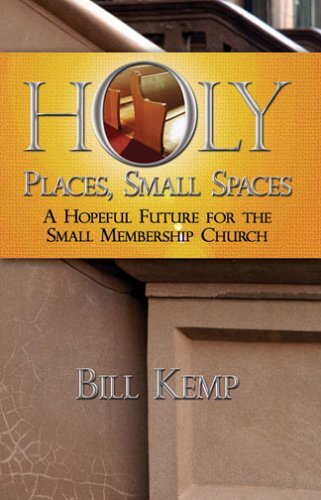Bill Kemp, Holy Places, Small Spaces: A Hopeful Future for the Small Membership Church. Discipleship Resources, 2005.
Referenced in: Small Church Leadership
LifeandLeadership.com Summary
This is a kind of “State of the Small Church Address.” It is more than that, but it certainly gives the most comprehensive demographic analysis and sociological data on the place of small churches in the American religious landscape. Like most books of this genre, the author affirms and encourages those who belong to or lead small-membership churches. He also suggests strategies for small church renewal. This is probably not the place to look for leadership strategies, but it is good for an objective and compassionately critical look at the abiding value of small churches in God’s economy.
From the Publisher
What is 52?
This number represents the average weekly worship attendance in half of The United Methodist Churches in the United States. Whether one speaks about Baptists, Presbyterians, Episcopalians, or Lutherans, none has a median church attendance exceeding 125.
Instead of declaring small-membership churches stuck between death and trying to be something they aren’t, Kemp encourages pastors and members of small churches to understand they, too, can engage in vital, realistic ministry.
“This book seeks not only to affirm the importance of small membership churches, but also to discern the problems and the myths that, if addressed, will return the small membership church to its rightful place at the center of Christian outreach to our contemporary culture,” writes Kemp. “My hope is to not only survey the landscape, but provide several simple concepts, which will aid small church leaders make their churches vital and sustainable.”
Unlike other books on this topic, Holy Places, Small Spaces takes a critical look at how small-church fellowships are faring compared to other congregations. It addresses the critical clergy supply problem and charts the changes that must take place for there to be a hopeful future of survival and growth for these congregations.
Kemp also provides important evaluative tools for leaders to measure their ministry.
About the Author
Bill Kemp has served for twenty-four years as a United Methodist pastor in a variety of parish settings across three conferences and six districts. His current appointment as an intentional interim minister for the Western Pennsylvania Conference involves short-term ministry to churches that are experiencing conflict or unusual leadership needs.
***For additional information on this resource, including reviews, click the bookstore links. Check the reference at page top or the links below for resource guides on related topics.***
Related Areas
See Other Resources on Small Churches:
See Other Resources on Church Leadership and Renewal:
See Resources on Over 100 Areas of Ministry Leadership:


